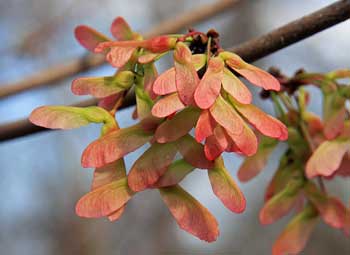Maple seeds dropping in soon
2012 provides a bumper crop of these maple “helicopters” and “whirligigs.”
Most of the horticultural news this spring has been dominated by what we don’t or won’t have this year due to late frosts; peaches, cherries, blueberries, plums and on and on. One crop we have in abundance, however, is maple samaras.
|
More commonly referred to as “helicopters,” “whirlers,” “twisters” or “whirligigs,” samaras are the winged seeds produced by maple trees. All maples produce samaras, but red, silver and Norway maples often produce the largest quantities. Over the next few weeks, these seeds will rain down on lawns, decks, roofs and gutters in many locations. These can become a nuisance, especially if they clog gutters and down-spouts or germinate in garden beds.
Homeowners and landscapers may also notice that heavy crops of samaras can make the upper portion of maple tree canopies look sparse. When trees put a great amount of resources into seed production, leaf production takes a back seat and trees look sparser than normal. However, with adequate moisture and normal summer temperatures, most people will not notice this by late June as trees will continue normal leaf development.
The main reason for the heavy seed crop this year goes back to stressed growing conditions in 2011, which helped produce above average flower bud numbers. Unlike the fruit tree crops, the timing and severity of our late freezes managed to miss the maple seed crop. This type of issue is often present in commercial fruit tree orchards and is termed “alternate bearing” with some years a light crop of fruit and others being a heavy crop year.
As noted, heavy seeding should not pose an issue for long-term tree health, but homeowners should be ready to rake, sweep and pull maple seedlings over the next few weeks.



 Print
Print Email
Email



